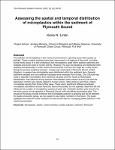Assessing the spatial and temporal distribution of microplastics within the sediment of Plymouth Sound
| dc.contributor.author | Lintin, K.N. | |
| dc.date.accessioned | 2023-12-22T16:18:05Z | |
| dc.date.available | 2023-12-22T16:18:05Z | |
| dc.date.issued | 2023 | |
| dc.identifier.citation |
Lintin, K.N. (2023) 'Assessing the spatial and temporal distribution of microplastics within the sediment of Plymouth Sound', The Plymouth Student Scientist, 16(2), pp. 69-93. | en_US |
| dc.identifier.uri | https://pearl.plymouth.ac.uk/handle/10026.1/21846 | |
| dc.description.abstract |
The pollution of microplastics in the marine environment is a growing issue that impacts us globally. These invasive particles have been discovered in all regions of the world, including human body tissue. It is well understood that microplastics settle within seafloor sediment and hotspots are found close to human activity. However, the way microplastics are distributed both spatially and temporally in urban marine environments, and why this might be, is little known. Using the ‘primary analytical process’, a study was conducted in Plymouth Sound, United Kingdom, to assess how microplastics were distributed within the sediment here. General sediment samples and core sediment samples were extracted from 8 sites. Zinc Chloride was used to separate microplastics from sediment samples and the ‘Guide to Microplastic Identification’ was followed during analysis. Microplastics were present at every site and the distribution of them was closely related to human activity. Sites closer to land had a higher microplastic density than those further away. There was a significant difference between microplastic abundance across Plymouth Sound temporally, but not spatially. Sediment did not influence the number of microplastics present at each site. Synthetic textiles were found to be the main source of microplastics in Plymouth Sound, with microfibres dominating sites. The results of this study provide evidence that microplastic pollution is growing and as the demand for plastic production grows, we can expect to see higher numbers in the future. The study highlights the need for further research as well as the need for managing plastic pollution in the marine environment. | en_US |
| dc.language.iso | en | en_US |
| dc.publisher | University of Plymouth | en_US |
| dc.rights | Attribution 3.0 United States | * |
| dc.rights.uri | http://creativecommons.org/licenses/by/3.0/us/ | * |
| dc.subject | Microplastic | en_US |
| dc.subject | plastic | en_US |
| dc.subject | marine pollution | en_US |
| dc.subject | plastic pollution | en_US |
| dc.subject | sediment | en_US |
| dc.subject | Plymouth | en_US |
| dc.title | Assessing the spatial and temporal distribution of microplastics within the sediment of Plymouth Sound | en_US |
| dc.type | Article | en_US |
| plymouth.issue | 2 | |
| plymouth.volume | 16 | |
| plymouth.journal | The Plymouth Student Scientist |



